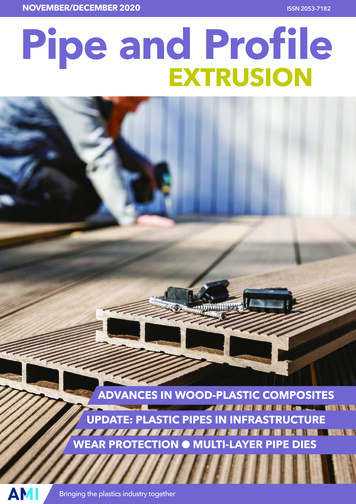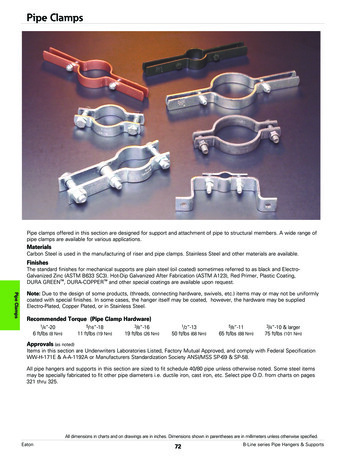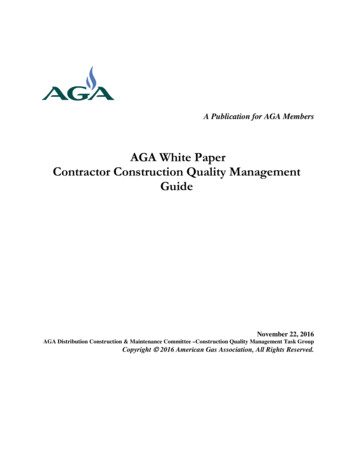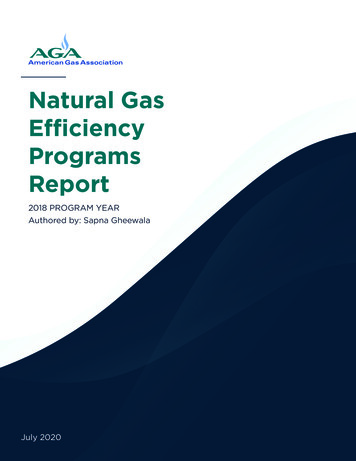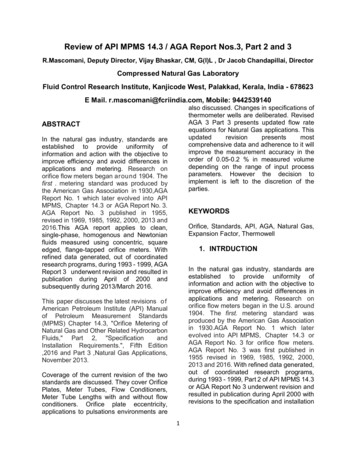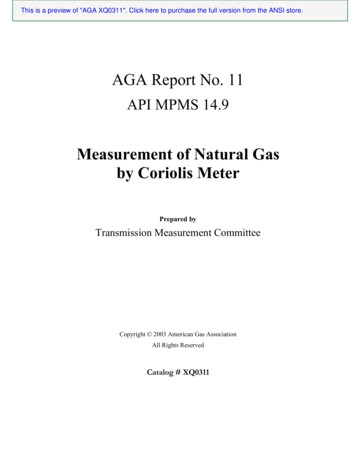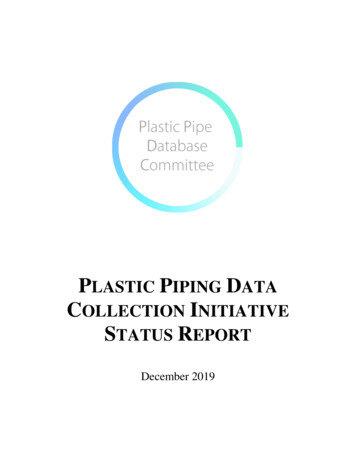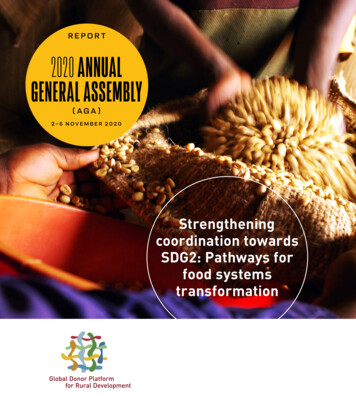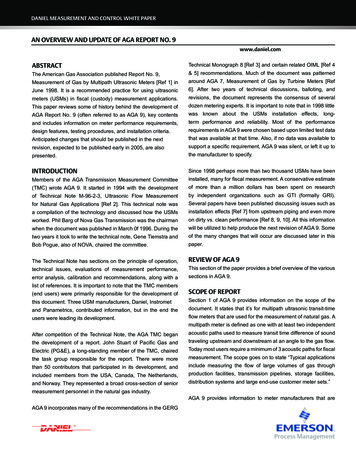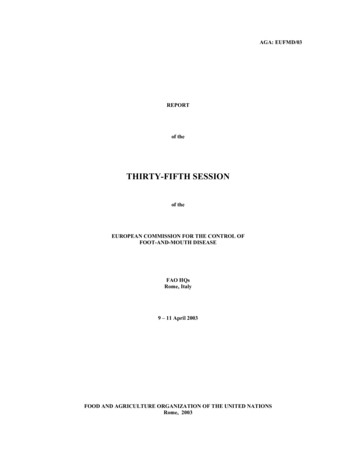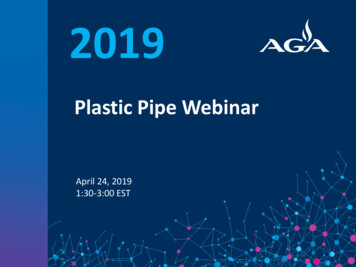
Transcription
2019Plastic Pipe WebinarApril 24, 20191:30-3:00 EST
The American Gas Association,founded in 1918, represents morethan 200 local energy companies thatdeliver clean natural gas throughoutthe United States. There are morethan 74 million residential,commercial and industrial natural gascustomers in the U.S., of which 94percent — more than 70 millioncustomers — receive their gas fromAGA members. Today, natural gasmeets more than one-fourth of theUnited States' energy needs.
Overview of PlasticPipe Regulation3
Applicability The amended regulations apply to new,repaired and replaced plastic pipe used inthe transportation of natural gas. Effective Date: January 22, 2019, except for somemarking aspects (December 31, 2019) Some concerns raised on effective datevia AGA Petition for Reconisderation(more later)
New or Updated Standards § 192.7 (Documents Incorporated by Reference) Item I, Appendix B (Listed Pipe Specifications and OtherListed Specifications for Components (new)) 16 new or updated standards ASTM D2513-12ae1 for PE (includes some aspects ofTracking and Traceability – new 16 digit code) New suite of standards for PA-11 and PA-12 pipe andfittings (replace ASTM D2513-99 and ASTM D2513 thatpreviously applied to thermoplastic pipe other than PE) Several new IBR standards for components (fittings)
Traceability and Tracking PHMSA delayed adopting the proposed definitions of“traceability information” and “tracking information”in §192.3. PHMSA delayed tracking and traceabilityrecordkeeping requirements proposed for §192.63,§192.321 and §192.375 Distribution operators still expected to collect someform of tracking and traceability information underDIMP §192.1007(a)(5) location where new pipelineinstalled and material of which it is constructed7
Traceability and Tracking The incorporated 2012 editions of materialstandards for polyethylene (PE) and polyamide(PA-11 and PA-12) pipe require operators tomark plastic pipe with the 16 character ASTMF2897-11a markings. This will promote standardization in howcomponent attributes are marked.
Marking of Materials (§192.63) Plastic pipe and componentsmanufactured after December 31, 2019must be marked in accordance withlisted specification Intended to give manufacturerstime to figure out application of 16character code based on durabilityrequirements All physical markings on plasticpipelines must be legible until time ofinstallation (originally proposed aspermanent)Image source: https://napipelines.com/checking-ids/
Design and Limitations 49 CFR §§ 192.121 and 192.123 have been merged(192.123 removed) §192.121 reformatted slightly with general requirementsfirst, then any additional requirements by material type (a) design formula for plastic pipe (b) general requirements for plastic pipe (c) PE pipe requirements (d) PA-11 pipe requirements (e) PA-12 pipe requirements (f) Reinforced thermosetting plastic pipe requirements
Increased Design Factor (PE) The allowable design factor for new andreplaced PE pipe is increased from 0.32 to0.40 in §192.121 under certain limitations Minimum wall thickness provided forvarious diameters The higher design factor also applies to pipesizes less than one-inch Iron Pipe Size (IPS)and Copper Tubing Size (CTS).
Expanded Use of Polyamide-11 Pipe The design factor for PA-11 pipe remains at0.40 in §192.121. Maximum operating pressure is increasedfrom 200 psig to 250 psig if using PA32316. Maximum pipe diameter is increased to sixinches (previously 4 inches).
Expanded Use of Polyamide-11 Pipe The increased design factor also applies tosmall diameter pipe. ASTM F2945-12a, an Industry Standard forPA-11 pipe, is incorporated by reference.Image source: markets/oil-and-gas/
Permitted Use of Polyamide-12 Pipe PA-12 pipe is permitted for use with adesign factor of 0.40 in §192.121. Maximum operating pressure is 250 psig forpipe up to six inches in diameter. ASTM F2785-12, an Industry Standard forPA-12 pipe, is incorporated by reference(IBR).
Permitted Use of Polyamide-12 Pipe ASTM F2767-12 is IBR and sets forthspecifications for electrofusion fittings onPA-12 systems.Image source: es-pa-12-tubes/
Wall thickness table with error1” CTS minimum wallshould be 0.101(same error in tablesfor PA-11 and PA-12)
Design and Construction of Risers New § 192.204 added for risers installed aftereffective date Must be tested to ensure safe performance underanticipated loads Factory assembled anodeless must be designed andtested in accordance with ASTM F1973-13 All risers used to connect regulator stations to mainsmust be rigid and designed to provide adequatesupport and resist lateral movement Anodeless risers must have rigid casing Operators may install field-assembled anodelessrisers
Qualifications of procedures andindividuals to make joints § 192.281 (Plastic Pipe) Heat fusion joints on a PE pipe or component (exceptelectrofusion joints) must comply with ASTM F262012 § 192.285 (Plastic Pipe: Qualifying persons to makejoints) PE Heat fusion joints (except electrofusion joints)visually inspected and tested in accordance withASTM F2620-12 Some concerns raised on timing needed to updateprocedures and train/qualify individuals
Fittings (§192.281(e) and 192.283 (b)) Mechanical fittings must meet listedspecification Must be Category 1 as defined by listedspecification for application material– Seal plus resistance to a force suchthat pipe fails outside joint area Some concerns identified related to– availability of fittings 4” or larger,particularly for transitions betweenplastic and other materials (like castiron)– Time needed to test and validate tonew IBR standardsImage source: https://www.elsterperfection.com/
Error to be corrected§ 192.283 Plastic pipe: Qualifying joining procedures.(a)(3) For procedures intended for non-lateral pipe connections,perform testing in accordance with a listed specification. If the testspecimen elongates no more than 25% or failure initiates outside thejoint area, the procedure qualifies for useShould be “no less than ” similar to aswritten in § 192.367 and § 192.281 (e)(4)
Installation by Trenchless Excavation §192.329(a) and §192.379(a) have beenrevised to specify that operators take stepsto provide sufficient clearance from otherunderground utilities and/or structures atthe time of installation. The definition of “weak link” in §192.3 hasbeen revised to include a “device ormethod”.
Joining Plastic Pipe PHMSA has removed the diameterrestrictions for socket-fusion joints from§192.281(c)(2). Such fittings must still comply with the listedspecification, which may have their owndiameter restrictions.
External Corrosion Control for Fittings –192.455 (g) Newly installed electrically isolated metalfittings must be cathodically protected andmaintained in accordance with operator’sintegrity management plan. This is not required for existing fittings.
Repair of Plastic Pipe §192.720 has been added to specify mechanicalleak repair clamps cannot be used as apermanent repair on plastic pipe.
Equipment Maintenance andCalibration§192.756 Joining plastic pipe by heat fusion; equipment maintenanceand calibration.Each operator must maintain equipment used in joining plastic pipe inaccordance with the manufacturer's recommended practices or withwritten procedures that have been proven by test and experience toproduce acceptable joints.
Other Amendments PVC pipe is permitted for use (NPRMproposed to prohibit for new installations) ASTM F 2817-10 incorporated formaintenance or repair ASTM D2564-12 (Spec for solventcements for PVC) IBR for Type B regulated onshore gathering linesconstructed with plastic pipe must complywith the plastic pipe regulations.
Petition for ReconsiderationOn March 1, 2019 PHMSA responded to AGA’s petition toreconsider and granted operators additional time toimplement training and operator qualification programs forthe new requirements, an additional 90 days to work withequipment suppliers, and an additional six months to complywith certain provisions that require the development of newprograms.PHMSA also delayed the compliance deadline for category 1requirements in § 192.281(e)(4), for joints between metallicand plastic with nominal pipe size (NPS) of 4 or greater.An official notice in the federal register addressing the petitionalong with other errors found in the rule will be forthcoming.
Petition for Reconsideration
IndustryQuestions29
Questions§192.59 Plastic pipe.New plastic pipe is qualified for use under this part if:(1) It is manufactured in accordance with a listed specification;(2) It is resistant to chemicals with which contact may be anticipated; and(3) It is free of visible defects.Clarification:Clarify what is meant by “visible defects”. During construction, new plasticpipe gets nicked up, and may not be “free of visible defects”. So as aclarification, maybe say “defects greater than 10% of the pipe wall”.
Questions§192.121 Design of plastic pipe.(b) General requirements for plastic pipe and components.(2) Plastic pipe may not be used where operating temperatures ofthe pipe will be:(ii) Above the temperature at which the HDB used in the designformula under this section is determined.Clarification:There are concerns that some regulators may interpret this section to meanthat the that a section of pipe cannot be used when the temperature of thepipe exceeds the temperature selected for the hydrostatic design basis (HDB)of the pipe.Ex. A field crew finds a leak in the middle of the summer on a sunny day where the ambienttemperature is 90 F. Once the crew exposes the pipe to inspect the pipe and the source of theleakage, the pipe will be operating at a temperature greater than or equal to 90 F and above the73 F at which the HDB was established.
Questions§192.204 Risers installed after January 22, 2019.(a) Riser designs must be tested to ensure safe performance underanticipated external and internal loads acting on the assembly.Clarification:1. Does 192.204(a) apply only to manufacturers or to steel riser made inhouse as well? If so what type of testing is needed to show that it performssafety under anticipated external and internal loads?2. Need to better understand regulator station riser design requirements. Isthis for plastic risers or metallic risers connecting to plastic main some pointdownstream?
Questions§192.281 Plastic PipeClarification:1. Are operators still required to qualify heat fusion joint procedures as statedin 192.283 now that 192.281(c) requires all heat fusion joining to comply withASTM F2620-12? If all utilities are required to follow F2620-12 it would seemunusual that everyone would then set up testing to qualify a mandatoryjoining process.2. If a PA12 fitting intended for use on existing PVC gas pipe meets F2785,does this satisfy 192.281 (e), (3)?3. If so, what are the performance requirements/applicable testing methodsfor such fittings? We currently feel that any requirements and test methodslisted in F2785 minus the pipe specific portions would apply.4. F2785 does not have a Category 1 criteria to satisfy the requirements of192.281 (e), (4), what would be the appropriate way to test/meet a Category 1status for these types of fittings?5. Previously, these fittings were designed and stamped to ASTM D2513,however, the version of D2513 (12ae1) that is now IBR has stipulations (seebelow) that now make any fitting not made from PE to be non-applicable tothis standard.
Questions§192.283 Plastic pipe: Qualifying joining procedures.(a)(3) For procedures intended for non-lateral pipe connections, performtesting in accordance with a listed specification. If the test specimenelongates no more than 25% or failure initiates outside the joint area, theprocedure qualifies for use.Clarification:1. Clarify that “no more than 25%” is an error.2. It is not clear to use how a piping joining procedure for making mechanicalplastic pipe joints must be qualified with a listed specification based upon thepipe material. This new addition requires clarification. It is not clear what isdesired by referring the operator to the pipe specification for PE, PA-11, PA-12,or any other plastic material being utilized for mechanical fittings.
Questions§192.329 Installation of plastic pipelines by trenchless excavation and§192.376 Installation of plastic service lines by trenchless excavation.Clarification:1. What does “pulled through the ground” mean? Typically, a hydraulic moleor rod pusher to make a penetrating hole under the street and then pull theplastic service line pipe back through the ground. This is typically done byhand, so would we need to use a weak link here? Consider using the term“Horizontal Directional Drill (HDD)” to reference anywhere we would use aweak link.2. Weak Link on small diameter pipe. If this is still a requirement, can we atleast limit it to mechanically pulled in pipe? Service tubing is often fed in byhand. Should service tubing installed using missile/mole should be exemptedfrom weak link requirement?3. What constitutes a weak link? Is there a widely accepted industry standardfor a “method” to prove elongation hasn’t occurred.
QuestionsSubpart I – Requirements for Corrosion Control1. 2” and smaller mechanical couplings are factory coated and we have nohistory of coupling failure of this size due to corrosion. Does this meet192.455(f) so that we won’t need to protect isolated coupling of this size?2. For a particular size coupling is there a recommended anode size to use andwhat’s the prefer method to connect to the anode? Some couplings do nothave lead for anode connection3. Are test stations required to monitor isolated couplings or can it beprotected with anode and monitor through leak survey?4. “Ensure all
Previously, these fittings were designed and stamped to ASTM D2513, however, the version of D2513 (12ae1) that is now IBR has stipulations (see below) that now make any fitting not made from PE to be non-applicable to this standard. Questions §192.283 Plastic pipe: Qualifying joining procedures. (a)(3) For procedures intended for non-lateral pipe connections, perform testing in accordance .
